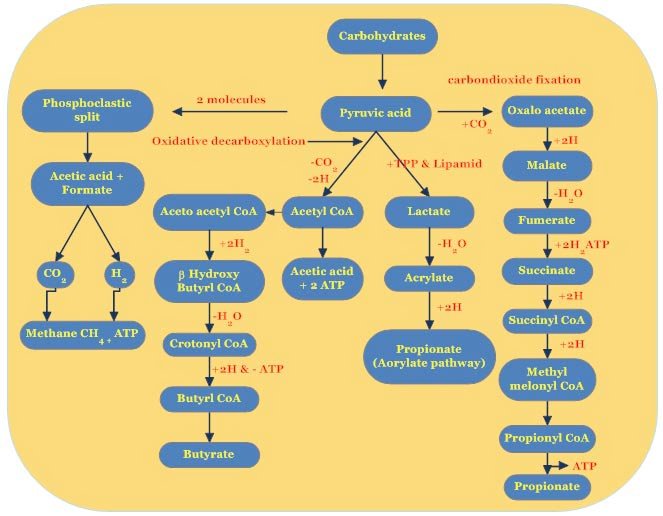TABLE OF CONTENTS
Degradation of different carbohydrates
Four steps are involved in the degradation of carbohydrates. these are Adherence, Disaggregation, Extra-cellular and Intra-cellular degradation.
1. Adherence
Adherence is the most important factor in fiber digestion. Coccoid show preference to get attached to plant cell wall. Adherence helps the bacteria to be retained for a longer time and facilitates sustained action.
This attachment helps the cell bound enzymes of adhered bacteria to come into intimate contact with substrate and ensure that resulting degradation products are preferentially available.
Factors affecting the adherence
pH– At a pH below 5.0 adherence decreases and is facilitated at the pH of 5.5 to 7.8
Temperature– Adherence is maximum at 40 0C.
Lignin and lignified portions of the plant cell wall are inhibitory. Soluble cellulose derivatives like carboxy methyl cellulose and methyl cellulose are inhibitory.
Certain compounds like phenyl propionic acid increases attachment with plant cell wall.
2. Disaggregation
The fibrous feeds are soaked in the rumen fluid and are broken to small pieces. Starch granules are easily attacked when ground. Lignin inhibits degradation of structural carbohydrates.
3. Extra-cellular degradation
The rumen liquor is the best source of bacterial and protozoal enzymes, which are secreted by the microorganisms and released into the rumen liquor.
The food substances that are soaked in the rumen fluid are acted by these microbial enzymes and degraded into short chain oligosaccharides and sugars.
4. Intra-cellular degradation
The oligosaccharide and disaccharides are degraded to simple sugars prior to engulfment by bacteria.
The simple sugars enter into the bacterial cell for further metabolism by the microbes. The sugars are metabolized in the microbes by phosphoroclastic cleavage by intracellular enzymes and leads to the formation of pyruvate, phosphophenol pyruvate, short chain fatty acids,CO2 and methane (CH4). During this process, 2 NAD are reduced to NADH.
Starch is degraded by bacterial enzymes to maltose and some glucose. Maltose is further fermented to glucose. Glycolysis is the major pathway of fermentation of glucose and other monosaccharides. Conversion of hexose to two molecules of pyruvate yields two ATPs, the main energy source for growth and maintenance of bacteria.
Cellulose is converted to glucose by cellulases and then to pyruvate by a complex process. Cellulose exists in amorphous and crystalline forms; crystalline form is the most difficult to degrade in the rumen. Hemicellulose is also degraded by cellulases similar to cellulose. Pentose sugars are produced from hemicellulose.Pectins are degraded to galacturonic acid, methyl esters of galacturonic acid and finally converted to short chain fatty acids.
Pyruvate is the intermediate product of carbohydrate metabolism in ruminants which is converted to short chain fatty acids, CO2 and CH4. During this process, ATPs are formed which are utilised for microbial growth and multiplication.
The microbes do not require CO2 and CH4 for their growth, whereas the short chain fatty acids are the major energy source for the host animal (ruminants). Concentration of short chain fatty acids in the rumen is within a range of 60 to 120mmol/L of rumen liquor.

Formation of volatile fatty acids
Acetic acid formation
- Oxydative decarboxylation of pyruvic acid
- Pyruvic acid is converted into Acetyl-CoA by the removal of CO2 and H2, in the presence of thiamine pyrophosphate (TPP) and lipomide. The Acetyl-CoA yields acetic acid.
- Phophoroclastic split
- Two molecules of pyruvic acid yield one molecule of acetic acid and formic acid. The formic acid is converted to CO2 and H2. The methanogenic bacteria utilises a portion of this H2 for CH4 production, whereas the other portion of H2 will be utilised for the production of succinate, propionate, butyrate, lactate as well as hydrogenation of unsaturated fatty acids.
2CH3-CO-COOH CH3-COOH + HCOOH CO2 + H2 +ATP + CH4
Propionic acid formation
- By CO2 fixation
- CO2 combines with pyruvic acid to form oxalo acetic acid (CH2COOH CO COOH) which is then reduced by hydrogenation (+2H) to malic acid;
- On removal of one water molecule malic acid is converted to fumaric acid (CHCOOH CHCOOH).
- Addition of H2 and one molecuel of ATP to fumaric acid results in the formation of succinic acid
- Decarboxylation (- CO2) of succinic acid yields propionic acid (CH3 CH2 COOH).
- By acrylate pathway
- Pyruvic acid on hydrogenation (+2H) forms lactic acid (CH3CHOH COOH)
- On removal of water lactic acid is converted to acrylic acid (CH2CH COOH) on hydrogenation (+2H) it yields propionate.
- Butyric acid
- Two molecules of acetyl-CoA condense to form acetoacetyl-CoA and 2H2. On reduction (+2H) acetyl-CoA is converted to beta hydroxy butyrl CoA, which by the removal of one molecule of H2O is converted to crotonyl CoA. Reduction of crotonyl CoA leads to formation of Butyrl CoA along with one molecule of ATP . The butyrl CoA yields butyrate (CH3CH2CH2COOH).
- During the formation of acetate and butyrate NAD is generated.The production of acetate leads to generation of ATP and formation of excess NADH. During the formation of propionate NAD is regenerated with a release of free hydrogen and this H is subsequently used to reduce CO2 to CH4 and H2O.
- Thus there is a direct relationship between acetate and CH4 production.when more acetate is produced from pyruvate, more CH4 is also produced.
- Likewise, there is a reciprocal relation between propionate production and CH4 formation; as more pyruvate is converted to propionate production, CH4 formation is reduced.